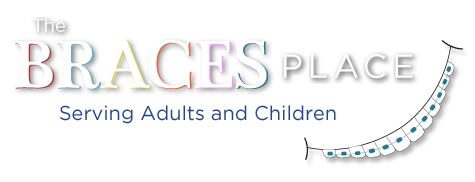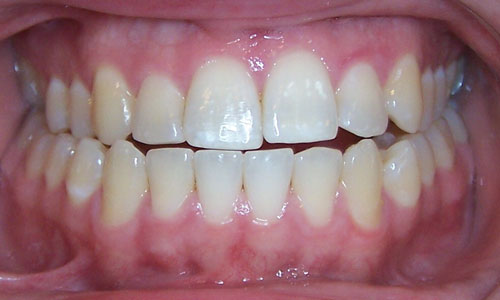INTRODUCTION TO JAW EXPANSION
The term jaw expansion refers to “widening” of the back teeth. In general, the upper set of teeth should fit around (outside) the lower set of teeth. As such, the upper jaw should be “wider” than the lower jaw.
The upper jaw is usually the one undergoing expansion. Expansion of the lower jaw is occasionally utilized, but a very unusual and dubious treatment. Expanders can be fixed (glued in) or removable.


Fixed expanders are generally preferred over removable appliances, because removable appliances require patient cooperation to be successful. Most patients are less than perfect in their cooperation.
WHEN TO EXPAND:
Posterior Crossbites:
Expansion is generally utilized when the upper jaw is too narrow to fit around the lower jaw. As such, the upper jaw is widened until it fits around the lower jaw.
Crowding:
Expansion can also resolve crowding by enlarging the circumference in the are of the front teeth. As circumference increases, the dental arch perimeter increases. An enlarged arch perimeter allows crowded teeth to align along the greater perimeter.
Broadening the Smile – A dubious treatment:
Expansion for any reason other than Posterior Crossbites or Crowding is dubious. While some doctors try to “broaden” the smile via expansion, this “broadening” is not supported by the literature in orthodontics. In fact, the literature would advise against “broadening.”
Why not broaden? If no crossbites exist, and you expand the upper jaw, the upper jaw becomes too wide for the lower jaw. Therefore, the lower jaw must be expanded to fit the widened upper jaw. Widening of the lower jaw has a tendency to develop TMJ problems. Additionally, both jaws will be unstable and have a tendency to collapse back to their original position after treatment is complete.
AGE AND JAW EXPANSION:
Child Expansion
Children with crossbites should be treated as early as reasonable (generally not earlier than 5 years old if possible). Since children are growing, crossbites tend to force the jaw into non-centered positions, and the jaw can grow off center during childhood growth. Additionally, crossbites of children results in TMJ problems over time.
Expanding the upper jaw of a child is straight-forward, because the upper jaw is soft and formable before the age of 16 years.
Adult Expansion
Adults with crossbites should also be treated, but some level of TMJ damage will be apparent on the jaw joints (sometimes debilitating damage).
Treating adults with crossbites can be different than treating children with crossbites. Adults with crossbites are not growing. As such, many orthodontists only expand adults with crossbites using “surgically assisted” jaw expansion. This involves a surgery that cuts down the center of the upper jaw.
Interestingly, most adults that undergo surgically assisted jaw expansion do not need a surgery to solve their crossbite! They do not need “jaw expansion.” They often only need “dental expansion.”
Adults should carefully select their orthodontist to avoid unnecessary procedures. Visit the Adult Orthodontics section to learn more about adult treatment
SUPPORTING ARTICLES: (All evidence-based)
Nonsurgical Rapid Maxillary Expansion in Adults: Report on 47 Cases Using the Haas Expander
Chester S. Handelman; Lin Wang; Ellen A. BeGole; Andrew J. Haas. Angle Orthodontist, 2000;70(2):129-144.
Abstract
Rapid maxillary expansion (RME) in the adult is thought to be an unreliable procedure with several adverse side effects and, consequently, surgically assisted RME is considered the preferred procedure. The purpose of this paper is to study the efficacy of nonsurgical RME, and to determine the incidence of complications such as relapse of the expansion, pain and tissue swelling, tipping of the molars, opening rotation of the mandible and gingival recession. Rapid maxillary expansion using a Haas expander was examined in 47 adults and 47 children. A control group of 52 adult orthodontic patients who did not require RME was also studied. Students’ t-test, and the analysis of variance followed by the Scheffé test were used to determine if there were significant differences among time periods and among the 3 study groups. The mean transarch width increase was similar in adults and children who had RME; 4.6 ± 2.8 compared to 5.7 ± 2.4 mm for the molars and 5.5 ± 2.4 compared to 5.7 ± 2.5 mm for the second premolars. In the adults, transarch expansion and the correction of the posterior crossbites were stable following discontinuance of retainers (mean 5.9 years). If the expander was properly fabricated, and turned no more than once a day, the procedure was well-tolerated. Rapid maxillary expansion in adults flared the molars buccally only 3° per side. The mandibular plane and lower facial height were unchanged. The adults achieved 18% of their transmolar expansion at the height of the palate and the remainder with buccal displacement of the alveolus. The children achieved 56% of their expansion by an increase at the height of the palate with the remainder due to displacement of the alveolus. There was some buccal attachment loss (0.6 ± 0.5 mm) seen in the female subjects associated with RME, but the extent was clinically acceptable. This resulted in significantly longer clinical crowns, but rarely caused exposure of buccal root cementum. Complications were infrequently observed or of minimal consequence. The results indicate that nonsurgical RME in adults is a clinically successful and safe method for correcting transverse maxillary arch deficiency.
Rapid Palatal Expansion in the absence of Crossbites: added value?
Gianelly AA American Journal of Orthodontics and Dentofacial Orthopedics 11/2003; 124(4):362-5
As noted in a recent article, interest in rapid palatal expansion (RPE), which has traditionally been used to resolve crossbites, has increased markedly in the past 2 decades. Orthodontists using this procedure might be seeking to gain arch perimeter to avoid extractions. This treatment, which is most often started in the mixed dentitition, raises some interesting questions. One question is this: In the absence of a crossbite, is RPE necessary to gain arch width to avoid extraction treatment? If so, then is the maxillary arch perimeter the determinant in the extraction-nonextraction decision? Inconveniently, it is not the determinant, thus the flawed use of RPE in the absence of crossbites.
These questions are fundamental, because using the maxillary arch to decide whether to extract challenges the concept of mandibular arch-based diagnosis and treatment planning.
For this reason, it might be useful to evaluate the rationale for RPE treatment in the correction of crowding. RPE increases the perimeter of the maxillary arch and can provide space to correct moderate (3-4 mm) amounts of crowding. Because no treatment occurs in the mandibular arch, a logical question is this: How is space to be gained to resolve crowding in the mandibular arch? One view is that expansion of the maxillary arch is accompanied by spontaneous transverse expansion of the mandibular arch, with the implication that space would be available to resolve any lower arch-tooth discrepancy. This supposition is easy to assess because there are adequate data; The conclusion is that any spontaneous expansion provides almost no space to resolve crowding.
Because spontaneous expansion of the mandibular arch is extremely limited, appliances, such as the Schwartz appliance, have been placed to expand it actively, in part to gain space for alignment, and in part to avoid creating any Brodie syndromes. This treatment raises other questions because of the instability of transverse expansion of the mandibular intercanine dimension. For example, Burke et al performed meta-analysis of 26 articles in which the stability of the mandibular intercanine dimension treatment change was evaluated in 1233 patients; they concluded that the most prudent course is to maintain the original intercanine dimension. The authors list 26 studies and their findings, and the inability to expand the intercanine dimension more than 1+ mm is readily apparent. This might help to explain why the postretention intercanine dimension is not enlarged more than 1.1 mm in studies that emphasized long-term mandibular incisor stability. Also, relapse of expanded intercanine dimension has been correlated with mandibular incisor instability. The use of the maxillary arch as the template for the mandibular arch might jeopardize the stability of the mandibular arch by expanding it in areas that are known to be unstable.
It might be a demanding task to justify the use of RPE in the absence of crossbites, particularly because any correction of the molar relationship could be unstable.




